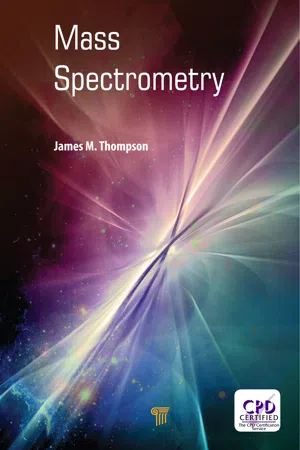
- 206 pages
- English
- ePUB (mobile friendly)
- Available on iOS & Android
Mass Spectrometry
About this book
It is estimated that there are about 10 million organic chemicals known, and about 100,000 new organic compounds are produced each year. Some of these new chemicals are made in the laboratory and some are isolated from natural products. The structural determination of these compounds is the job of the chemist. There are several instrumental techniques used to determine the structures of organic compounds. These include NMR, UV/visible, infrared spectroscopy, mass spectrometry, and X-ray crystallography. Of all the instrumental techniques listed, infrared spectroscopy and mass spectrometry are the two most popular techniques, mainly because they tend to be less expensive and give us the most structural information.
This book is an introductory text designed to acquaint undergraduate and graduate students with the basic theory and interpretative techniques of mass spectrometry. Much of the material in this text has been used over a period of several years for teaching courses in materials characterization and chemical analysis. It presents the mass spectra of the major classes of organic compounds and correlates the fragmentation pattern of each spectrum with the structural features of the compound it represents. This has been done for hydrocarbons, organic acids, ketones, aldehydes, esters, anhydrides, phenols, amines, and amides. The text discusses the origin of the fragments, techniques, innovations, and applications in mass spectrometry. It is interspersed with many illustrations, examples, an adequate but not overwhelming bibliography, and problems for students. It will serve as a lecture text for a one-semester course in mass spectrometry or can be used to teach the mass spectra portion of a broader course in material characterization and chemical analysis.
Frequently asked questions
- Essential is ideal for learners and professionals who enjoy exploring a wide range of subjects. Access the Essential Library with 800,000+ trusted titles and best-sellers across business, personal growth, and the humanities. Includes unlimited reading time and Standard Read Aloud voice.
- Complete: Perfect for advanced learners and researchers needing full, unrestricted access. Unlock 1.4M+ books across hundreds of subjects, including academic and specialized titles. The Complete Plan also includes advanced features like Premium Read Aloud and Research Assistant.
Please note we cannot support devices running on iOS 13 and Android 7 or earlier. Learn more about using the app.
Information
Contents
Table of contents
- Cover
- Halftitle
- Title Page
- Copyright page
- Table of Contents